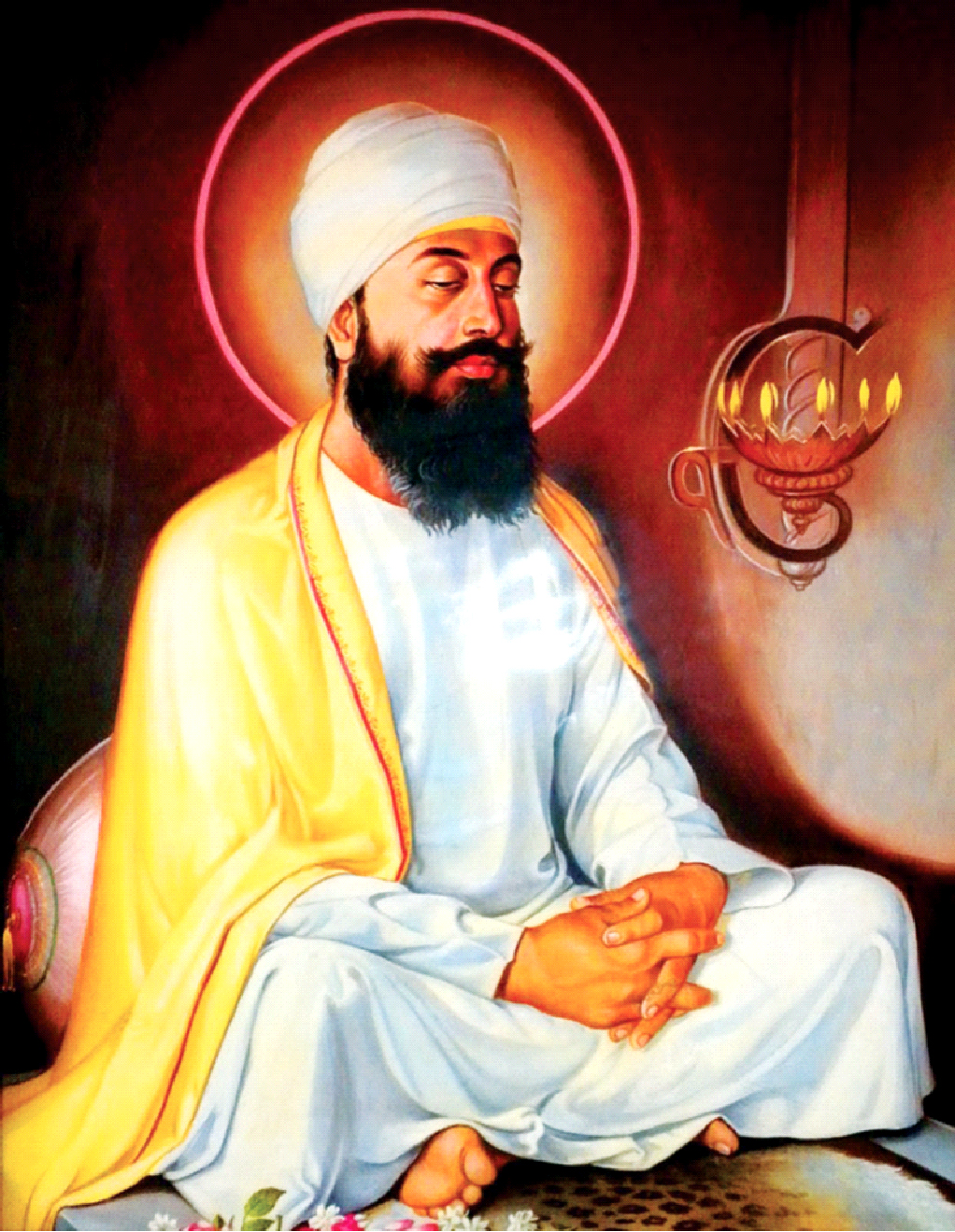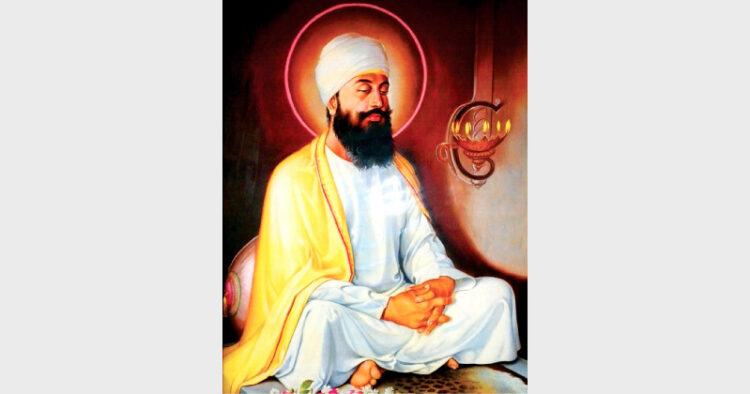 Sacrifice of Guru Tegh Bahadur symbolises war against injustice, a determination to stand up to atrocities, though it may mean sacrifice of the sel f
Sacrifice of Guru Tegh Bahadur symbolises war against injustice, a determination to stand up to atrocities, though it may mean sacrifice of the sel f
Dr Baltej Singh Mann
Today the freedom of thought, conscious and religion which we are enjoying is due to the sacrifices of great people. About 342 years ago Guru Tegh Bahadur made the supreme self-sacrifice fighting the tyrannical regime for the protection of freedom of conscious and religion in the country. Let us remember the 9th Guru when his martyrdom day falls this month.
Life Sketch
Guru Tegh Bahadur whose original name was Tyag Mal was born on April 1, 1621. The name of his mother was Nanaki. His father was Guru Har Gobind who organised a sangat darshan along with his three prominent Sikhs on the occasion of the birth of his son. They made a prayer for their son to serve the humanity with all his might throughout his life. On this occasion, the following prominent Sikhs were present: Ved Vyas of Sikh Panth, scholar Bhai Gurdasji, beam of service Baba Buddhaji and symbol of valour and bravery Bhai Bidhi Chandji. Guru Har Gobind also prayed before the Akal Purukh to bestow qualities of service comparable to Baba Buddhaji, learning and scholarship comparable to Bhai Gurdas and bravery comparable to Bhai Bidhi Chand. Consequently Guru Tegh Bahadur who represented the Guru Nanak tradition, followed the basic tenets of gurubani for the welfare of the humanity. In 1632 A.D., Guru Tegh Bahadur got married to Mata Gujriji daughter of Shri Lal Chand of Kartarpur. Valiant Warrior at the Age of 14
At the tender age of 14 years, Guru Tegh Bahadur sought permission from his father to show valour during the Battle of Kartarpur which was fought between Guru Hargobind and Shah Jahan in 1634 AD. Fierce battle ensued. On behalf of Guru Hargobind, Tegh Bahadur fought the battle with great valour and won it. Painda Khan who was fighting for Shah Jahan and who had fought with Guru Tegh Bahadur on earlier occasions was killed in this battle and his death was an end of his narcissism. Soon after this battle, Tyag Mal assumed the name of Tegh Bahadur in the real sense but his father Gurudev asked him to refrain from participating in future battles because he was destined to do a greater job of protecting dharma and the nation. His father also motivated him to do meditation. Thus, Guru Tegh Bahadur remained engrossed in penance and asceticism for about twenty years from 1644-1664.
Gurubani
Tegh Bahadur took over as the 9th Guru on March 30th 1664. He went to Sri Darbar Sahib, Amritsar on November 22nd, 1664 to pay his obeisance. Later he laid foundation of Anandpur ‘Chak Mata Nanki’ on June 16, 1665. The bani of Guru Tegh Bahadurji is compiled in ragas and is consisting of 56 shabads and 57 shalokas. As far as spirituality, morality, knowledge, and ideals are concerned, the bani of Guruji is in accordance with Guru Nanak’s tradition. The concept of ideal life in the bani of Guruji is unique. He says, “the lord is supreme and we are all under his command. Those people who are engaged in materialistic world develop various types of disorders and destroy their precious lives.”
Defying the Edict
When Aurangzeb acceded to throne in 1658 A.D., he started summoning the renowned and holy saints and asked them to show prowess and strictly
follow the rules of Shariat. He also ordered to destroy all Hindu temples (Maths), idols and dharamsals. Guru Tegh Bahadur defied all orders which infuriated Aurangzeb. Meanwhile Guru Tegh Bahadur left for preaching (dharam prachar) from 1666-69 and visited places in the east including Patna.
Meeting Kashmiri Pundits
On May 25th, 1675 A.D., Kashmiri Pandit Kripa Ram Dutt came to Guruji’s darbar at Anandpur along with 16 Brahmins to seek his patronage against the tyrannical Mughal regime which was forcing them to accept Islam. Pandit Kirpa Ram Dutt, who was also one of the teachers of young Gobind, made a fervent appeal to Guru Tegh Bahadur to follow his Kshatriya dharma to save their religion and freedom of conscious.
After listening to the aggrieved Brahmins, Guruji looked towards the sky and said that sacrifice of a great man is essential at this moment. Gobind Rai, who was hearing this conversation, came forward and asked his father (Guru Tegh Bahadur) as to who could be a greater person than him to sacrifice his life for the protection of Hindu Dharma. According to Panth Prakash by Bhai Gyan Singh, Guruji replied to Kashmiri Pandits: that “Oh Hindus! Be rest assured that the seat of Guru Nanak Dev is now occupied by Tegh Bahadur and tell Aurangzeb that he (Guru Tegh Bahadur) is our leader and first convert him to Islam then we will follow.” He assured them not to worry and feel scared as the
protector of dharma now exists.
Great Self-Sacrifice
On the orders of Aurangzeb, Guru Tegh Bahadur was arrested on July 12th 1675 from Malakpur (Ropar) along with his fellow Sikhs-Bhai Mati Das, Bhai Sati Das and Bhai Dayal Das. The rulers placed three conditions before Guruji—(i) to show miracle (ii) to accept Islam or (iii) be ready to be killed. Guruji accepted the third option hence he was tortured.
With a view to force Guruji to accept Islam, Bhai Dayal Das, Bhai Mati Das and Bhai Sati Das were brought under a tree near Kotwali at Delhi. The Royal Qazi issued an edict to kill three associates of Guruji before his eyes. As per the edict, Bhai Dayal Das was assassinated by throwing him in the boiling water; thereafter, the body of Bhai Mati Das was cut with saw; and finally Bhai Sati Das was wrapped with cotton and burnt alive. On seeing this scary and inhuman scene, Guruji said, Dhan Sikhi! Dhan Sikhi! (Long live Sikhi). He further said, “The martyrdom of these three has shaken the foundation of Turk Empire and this empire will not last long.” Their names will be remembered with reverence so long as this universe exists. There was hue and cry all around on seeing the martyrdom of these three Sikhs. When Guruji did not relent to accept Islam, the tyrannical rulers pronounced the killing of Guru Tegh Bahadur. Finally, on November 11th, 1675 Guru Tegh Bahadur was publically beheaded as he prayed. The sacrifice of Guru Tegh Bahadur symbolises war against injustice, a determination to stand up to atrocity, though it may means sacrifice of the self. The site of Guru Tegh Bahadurji’s execution was later turned into a famous Gurudwara named as Sis Ganj in Delhi. Gurudwara Rakab Ganj also in Delhi, stands testimony to the fact where the body of Guruji was cremated. Later Delhi Government also established a Guru Tegh Bahadur Memorial at Delhi. Millions of people of all social and
religious backgrounds pay homage to the guru at these shrines.
The sacrifice of Guru Tegh Bahadurji laid the foundation of the fall of the Mughals. Consequently, the cultural consciousness flourished among India’s oppressed people. The spirit of self sacrifice arose and fear of the Mughals vanished from the minds of the people. In today’s world, scarred by religious fanaticism and intolerance, he is truly a hero to be revered and emulated.
(The writer is former Dean, Punjabi
University, Patiala)














Comments